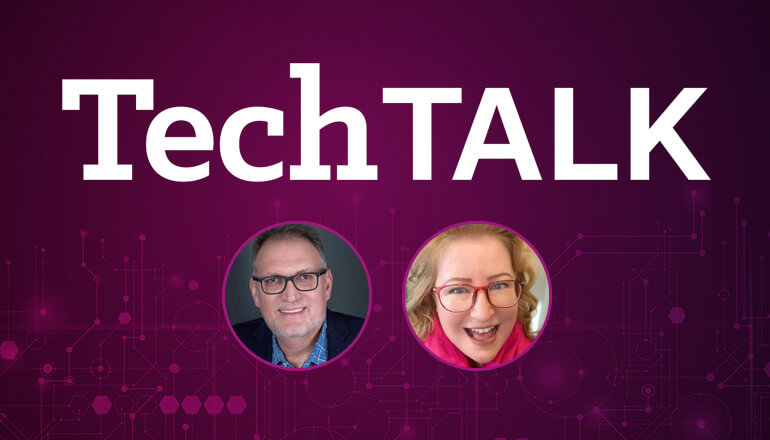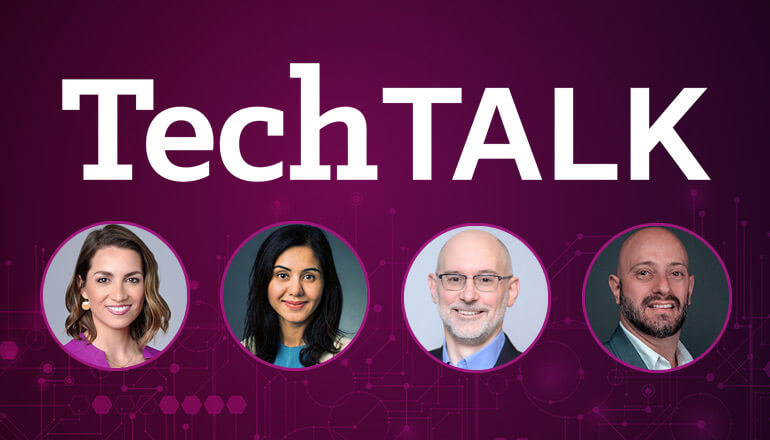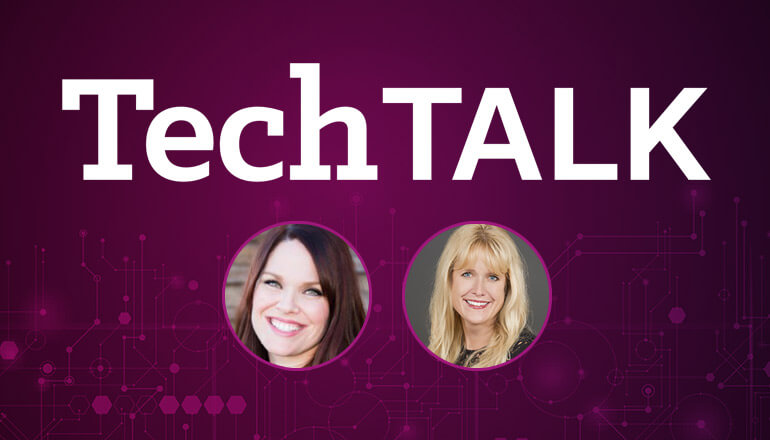Audio transcript:
Navigating Edge Computing With Dell Technologies
Andrew
Hi, good afternoon or good morning, wherever you are. I'm Andrew Nelson with Insight's Cloud and Data Center Transformation Group. I'm a principal architect in that team. This is an Insight Tech Talk and I'm joined by Allen Clingerman, who is our chief technology strategist of PowerEdge and Workloads for Dell Technology. Welcome, Allen.
Allen
Thank you for everybody joining us today.
Andrew
So today, Allen and I are going to have a brief chat around Edge computing and some of the challenges that we are seeing in the market for our clients in our industry. So, Allen, the first question I have for you is our industry is seeing growing demands around edge computing for IOT and remote workloads. Much of this interest is in the realization that these workloads require lower latencies, and due to that, geographical proximity that traditional data centers and public cloud can't always deliver. Insight has a huge push this year to help our clients navigate, implement and operate an intelligent edge strategy to address these distributed architectures. Can you talk about some of the solutions and initiatives that Dell has in this space?
Allen
Yeah, thanks for that question. In fact, a lot of interesting things going on at Dell Technologies today around the edge. And when I think about it, when I think about the edge, right, it really is that data is at the core of everything we do is as a business today, right? Literally at the, at the core of everything we do from a structured and unstructured data set that helps us make business decisions to drive new lines of revenue or profit, you know, comes from our stored data. And when I think about that, in fact, one of the things that came out of, if anybody had a chance to go to Dell Technologies World virtually this year, or by the way, if you've not had a chance, please go out there and listen. There's a great session from our CTO, John Rose, that talks about kind of this whole topic in the concept of a zetta scale edge data center. 'Cause we think about where things are going, right? We still think, many of us, in petabytes, or terabytes or petabytes depending on the size of your organization. But now to start thinking of zetta scale. Like, we're already thinking about it at Dell Technologies, like, what does that mean? Because it's not just about content that we're creating at the core, but you know really moving towards the edge. No matter which industry analysts you talk to, you might've seen, there are some predictions by IDC that 50% of enterprise data is going to be created outside of the core data center by next year. So even if you vary from that, just to say that over half of your data is going to be coming from that area, maybe you haven't thought about that, right? You're not working as closely with your operational technology teams where the physical touches the technical world, you know, what do we do with all this machine-to-machine data that's being created to create some type of actionable insights. And when I start thinking about it from a strategy perspective, we look at it of exactly what you said there, under of, of the constrain, right? Everything at the edge is constrained versus a controlled environment that many cases we have in the core data center. So, it's about, how do I take, if that point of data creation is going to be the edge, how do I rapidly inference to get business value from the time, close to the time where that data was created? And then over time how do I through processing and compression move it through data life cycle, just like we've been doing for many years in the core data center of ILM, right? This is, now it's the new ILM.
Things are just being created, you know, faster than they ever have. And those four Vs of big data become a very big challenge for all of us, in addition to the constraints at the edge. And we've been doing, not only do we have the strategy in place, but we're building a number of products around it. You might've seen that our XE extreme and emerging category and XR and extreme and ruggedized platforms are continuing to grow given those constraints in mind. So, things like two posts racks and short depth form factors and sometimes air-cooled environments, right? Are all the realities of what we deal with at the edge. So, no matter what type of ruggedness you require for your environment, we have you covered, whether it's just standard PowerEdge, by the way, a majority of PowerEdge can run at fresh air up to 104 degrees Fahrenheit, you know, without anything, just standard PowerEdge server out of the box, ready to go with cool air designs. But if I need something more ruggedized move up to XE, right? Where I can actually do some more inferencing, and it's more ruggedized and air filters for manufacture and retail environments. Or fully ruggedized with XR where I'm actually a field-based application. I'm in DOD, I'm out, you know, in the military or I'm in oil and gas doing exploration, right? To look for that next repository. So that's where XR comes in. And outside of the hardware platforms we think about the software frameworks, right?
When you think about our strategy it comes in extremely important when you think about open source, technologies that we've kind of combined in something called the Dell EMC streaming data platform as Apache Flink. Some of you may not be familiar with it but think about the ability to combine event driven application created data, streaming pipelines, and stream and batch analysis, all in one control plane. It's a pretty powerful tool. The next one, hopefully everybody knows if you've been doing any artificial intelligence with Apache Spark. And finally, another name that might be new to you is something called Pravega. Think about it as this new streaming storage abstraction layer that can handle things in more advanced manners than Kafka or Pulsar. So, lots of really cool technologies from both a hardware and software stack to make this a reality for our customers together.
Andrew
Yeah, thanks for that, Allen. That's great dialogue and all those technologies are very appropriate to this new wave of architecture that we're seeing at the edge. So, along those same lines, computing at the edge stretches our security perimeters and poses new challenges for clients. Updating and monitoring and managing all that stuff you just talked about, and securing it at the edge can add a fair amount of complexity, especially given that IT talent generally isn't at these locations, how is the Dell PowerEdge team and offerings addressing some of these new and, frankly, old challenges that we've had of remote management and what advances is Dell making toward truly autonomous compute infrastructure that I've heard in the trades about?
Allen
Yeah, certainly to your point it's old and new challenges alike, right? They don't go away. They just make themselves more and more relevant at the edge. And we look at it as kind of IT infrastructure that seamlessly supports data center and edge from a workload perspective no matter what hardware platform they have of standard PowerEdge, XE, or XR. we want to have a complete end-to-end software management stack to do all the things we've been struggling with for a long time, right? Whether it's unintended installations, lights out operations, full remote manageability of the platforms from a power on, power off post perspective, going in and making changes to it. Or, where many people are starting to go, of leveraging infrastructure as a code. I think it's going to become more and more important as we move forward because I'm going to have this proliferation of new devices that live at the edge where I don't have exactly what you said. There's no skilled talent. So, I need to really be able to double down. And I know you guys have some great skill set in that area, right? To really help a customer that haven't gone down that path. But it really is one of the key tenants of what we do in PowerEdge of exactly what you said earlier, of trying to get to just like a self-driving car. If you've ever looked at self-driving cars, you know there's five levels of autonomy.
We've rated ourselves along with a number of industry analysts to give us a good starting point of where we're at today. And we're trying to get to that full level five of autonomous infrastructure, right? Both compute storage and networking, to be able to make it just easier for a customer to manage this stuff so they can run their business as opposed to just managing the platforms. I think that's what everybody's looking for. How do I get outside of the day-to-day operations of running my infrastructure to actually use technology as a competitive differentiation and move towards innovation that the business is trying to leverage, right? To drive new lines of revenue and profit. And it certainly starts with iDRAC and OpenManage and our core assets. We've got well over 15 years' worth of engineering in, and by the way, we've really extended those out out to wherever the customer's managing their software assets today, in vCenter, or Windows Admin Center, or ServiceNow. Or certainly out to those infrastructures of code products I mentioned earlier. Customers have made huge investments with Ansible and Shift and Terraform. We have very robust roadmaps to make all that real for the customer, no matter where they're at in their journey.
Andrew
Yeah, you've mentioned a theme throughout these two questions already is, its management, management, management, management, all at scale. And being able to have the underpinnings to be able to do that as is where the edge is really going to show its its weakness or its strengths. So, along those same lines, we're seeing the shift from what we call a shift from data centers to centers of data in our current architectures. This is really the new version of the mainframe to open systems pendulum swing. Certain workloads and data sets are moving from legacy data centers to cloud, out to regions and remote facilities, disconnected and partially connected environments like oil rigs, self-driving vehicles, farm equipment, remote mining, so on and so forth. They all require robust, stand-alone and secure infrastructure. These workloads make use of cameras and video processing that require some form of server acceleration, whether it's an FPGA or GPUs to be able to make quick decisions and analyze the data onsite. What is the PowerEdge team doing to enable a lot of this enhanced compute that traditionally wasn't out at the edge?
Allen
And it was funny. I don't know if it was purposeful, Andrew, but every industry example you just gave are all living through that constraint at the edge. And by the way, whether they're able to take advantage of all this streaming telemetry data coming in from all the sensors in each of their industries, it's coming in. So, it's like, how do I be able, how can I utilize that data to be able to to achieve some type of business outcome? And we think about it, of those constraints at the edge, and you hit kind of the key tenants, but we look at it as environmental, dimensional, security, bandwidth and latency, agility, and cloud native type features, right? And skilled staff that you mentioned earlier. So, it's how do I get all of those core tenants wrapped into a baseline with adaptive compute and PowerEdge. And when I think about it, right, exactly what you said there, server acceleration is an interesting category that's growing very fast. It's highly contested. Competition's great for all of us, right, in the marketplace. And we're starting to see lots of innovation and competition here, whether it's, as you kind of alluded to, GPUs, FPJs or even some things that not everybody's heard out like intelligent processing units or data processing units that'll be coming out with DPUs later, and SmartNICs. So, lots of interesting technologies that really, we need to ensure that, as a platform, we can adapt quickly to take all of those core tenants and bring 'em into our platforms. We call it as, within PowerEdge, as adaptive compute. I kind of say it's like taking all those merchant silicone vendors that fit each of those categories and pulling those ingredients together and making an incredible cake that everybody wants to come consume, right? 'Cause here's this fantastic cake using all these technologies to be able to achieve some type of business result, right? That's the sugar, that's the icing on top. How do I go create value for my organization to drive new lines of revenue or profit or decrease operational costs?
Andrew
Well, if you guys are making the bakery, or if you guys are making the cake ingredients, Insight's the bakery. We like working working with Dell and thanks for this conversation. If any of this resonates with you, please reach out to Insight and Dell for follow-on conversations. This is a really hot topic for us, and 10 minutes doesn't do this justice.
Allen
Can't agree more.
Andrew
So, I appreciate your time, Allen. Thank you.
Andrew
You too, thanks everyone.










